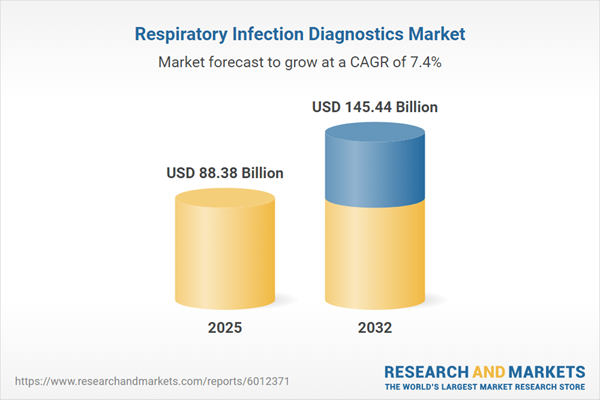Speak directly to the analyst to clarify any post sales queries you may have.
The respiratory infection diagnostics market is rapidly evolving to meet global healthcare demands, driven by innovation in testing technologies and the urgent need to manage outbreaks efficiently. The sector’s ongoing transformation is reshaping diagnostic capabilities, supporting both clinical and public health strategies with improved accuracy and accessibility.
Market Snapshot: Respiratory Infection Diagnostics Market Performance
The Respiratory Infection Diagnostics Market grew from USD 82.35 billion in 2024 to USD 88.38 billion in 2025. It is expected to continue growing at a CAGR of 7.36%, reaching USD 145.44 billion by 2032. This sustained growth reflects escalating incidence of respiratory pathogens such as influenza, respiratory syncytial virus, and coronaviruses, as well as persistent global investment in rapid and precise diagnostics. Market leaders are expanding product portfolios and entering emerging geographies, while new market entrants focus on accessible solutions to meet increasing screening volumes.
Scope & Segmentation of the Respiratory Infection Diagnostics Market
This report delivers comprehensive analysis across several key areas and market segments:
- Technology: Enzyme linked immunosorbent assay, lateral flow immunoassay, automated culture systems, conventional culture, loop mediated isothermal amplification, polymerase chain reaction, next generation sequencing, Sanger sequencing.
- Sample Type: Blood, nasal swab, saliva, sputum, throat swab.
- Test Mode: Laboratory based, point of care.
- Infection Type: Coronavirus disease, influenza, respiratory syncytial virus.
- End User: Clinics, home care settings, hospitals, research laboratories.
- Region: Americas (North America – United States, Canada, Mexico; Latin America – Brazil, Argentina, Chile, Colombia, Peru), Europe, Middle East & Africa (Europe – United Kingdom, Germany, France, Russia, Italy, Spain, Netherlands, Sweden, Poland, Switzerland; Middle East – United Arab Emirates, Saudi Arabia, Qatar, Turkey, Israel; Africa – South Africa, Nigeria, Egypt, Kenya), Asia-Pacific (China, India, Japan, Australia, South Korea, Indonesia, Thailand, Malaysia, Singapore, Taiwan).
- Company Profiles: F. Hoffmann-La Roche AG, Danaher Corporation, Thermo Fisher Scientific Inc., Abbott Laboratories, Siemens Healthineers AG, bioMérieux SA, Hologic Inc., QIAGEN N.V., Quidel Corporation, Becton, Dickinson and Company.
Key Takeaways for Senior Decision-Makers
- Rapid diagnostic innovation is fundamental to effective clinical outcomes and public health intervention, supporting decision making in diverse healthcare contexts.
- Laboratory automation, point of care solutions, and digital connectivity are reshaping workflows, enhancing both throughput and surveillance capabilities.
- Technology adoption varies by region, with some markets prioritizing high-throughput laboratory systems and others increasingly turning to decentralized, portable testing options.
- Partnerships among assay developers, regulatory bodies, and healthcare providers are accelerating product development and streamlining implementation of new platforms.
- Segment-specific strategies, including specialized assays and training initiatives, enable tailored responses to different infection types and end-user needs.
Tariff Impact on the Respiratory Infection Diagnostics Market
Recently introduced United States tariffs on essential components such as reagents and instrument parts are reshaping procurement strategies for diagnostic firms. Many manufacturers are broadening supplier networks and exploring domestic collaborations to offset increased costs. These measures have led to shifts in inventory management and greater emphasis on geographically diverse production to maintain resilience and mitigate financial exposure.
Methodology & Data Sources
This report aggregates findings from public literature, regulatory filings, conference materials, and peer-reviewed publications. Primary insights were validated through expert interviews and analysis of technology performance benchmarks. The methodology included scenario planning, triangulation of qualitative data, and peer review oversight, ensuring transparency and reliability at every stage.
Why This Report Matters for Strategic Planning
- Enables manufacturers and healthcare organizations to anticipate shifts in technology use and regulatory frameworks within the respiratory infection diagnostics market.
- Offers segment-specific guidance for portfolio alignment and market entry, helping leaders adjust strategies to local infrastructure, reimbursement policies, and end-user preferences.
- Facilitates informed risk assessment and opportunity evaluation through a comprehensive review of competitive positioning, supply chain resilience, and global trade impacts.
Conclusion
Organizations equipped with this analysis can proactively address evolving diagnostic requirements, regulatory landscapes, and regional variations. Strategic investment in adaptable platforms and robust supply chains will position industry stakeholders for sustained performance in the dynamic respiratory infection diagnostics sector.
Additional Product Information:
- Purchase of this report includes 1 year online access with quarterly updates.
- This report can be updated on request. Please contact our Customer Experience team using the Ask a Question widget on our website.
Table of Contents
3. Executive Summary
4. Market Overview
7. Cumulative Impact of Artificial Intelligence 2025
List of Figures
Companies Mentioned
The key companies profiled in this Respiratory Infection Diagnostics market report include:- F. Hoffmann-La Roche AG
- Danaher Corporation
- Thermo Fisher Scientific Inc.
- Abbott Laboratories
- Siemens Healthineers AG
- bioMérieux SA
- Hologic Inc.
- QIAGEN N.V.
- Quidel Corporation
- Becton, Dickinson and Company
Table Information
| Report Attribute | Details |
|---|---|
| No. of Pages | 184 |
| Published | October 2025 |
| Forecast Period | 2025 - 2032 |
| Estimated Market Value ( USD | $ 88.38 Billion |
| Forecasted Market Value ( USD | $ 145.44 Billion |
| Compound Annual Growth Rate | 7.3% |
| Regions Covered | Global |
| No. of Companies Mentioned | 11 |









